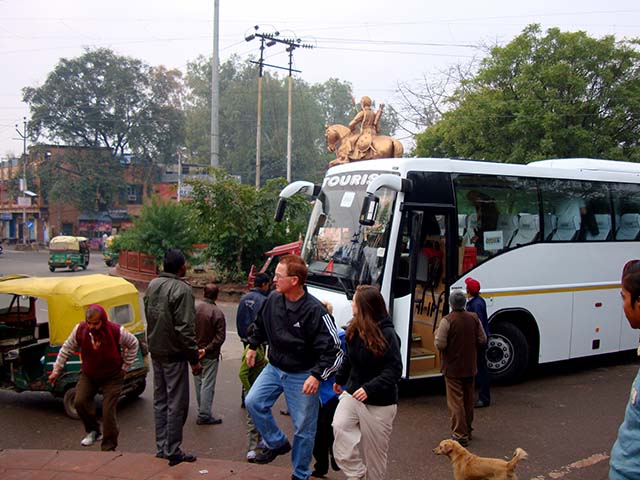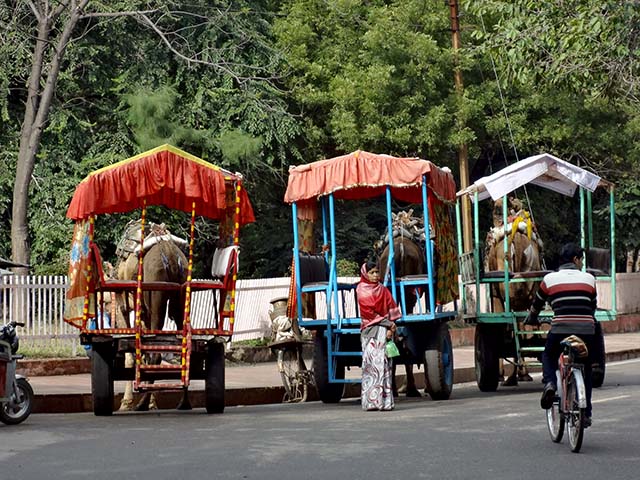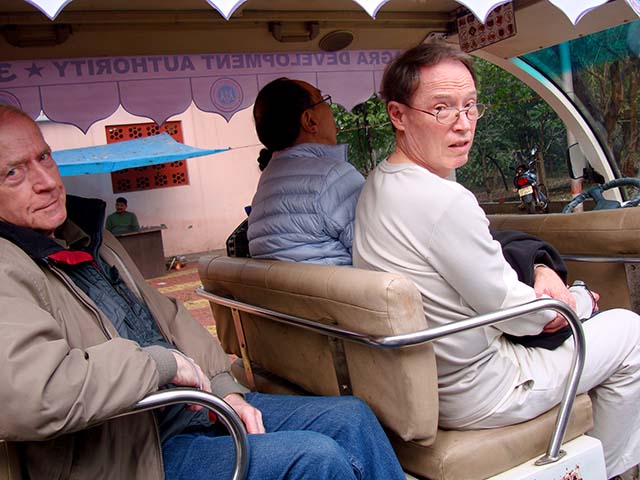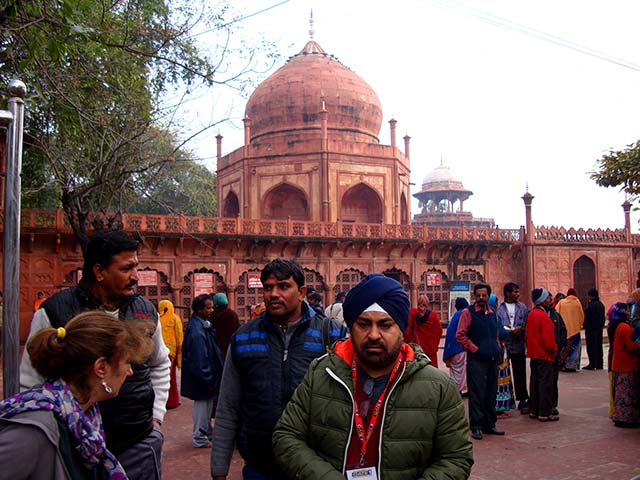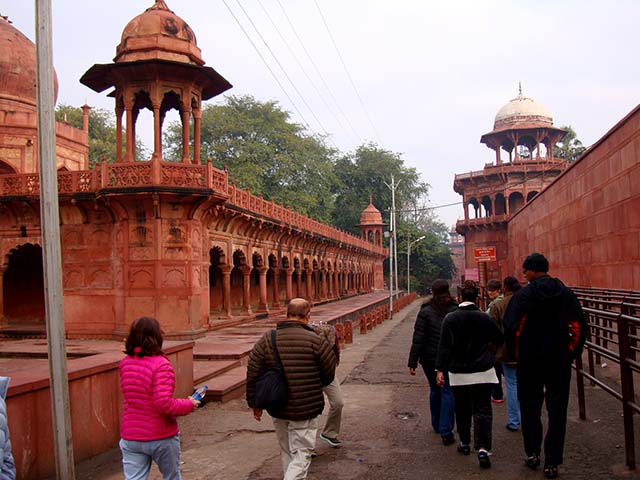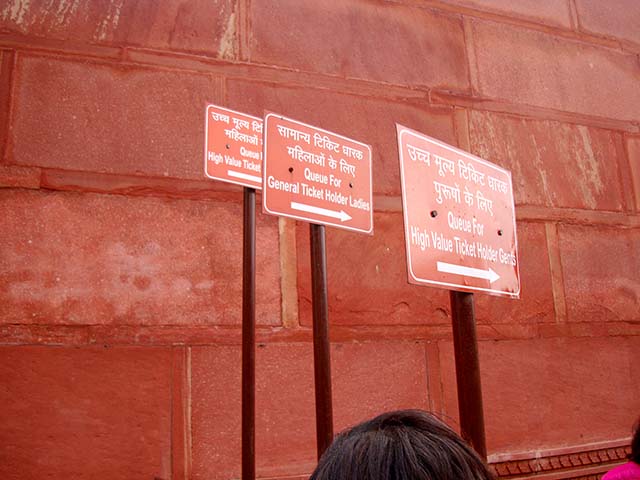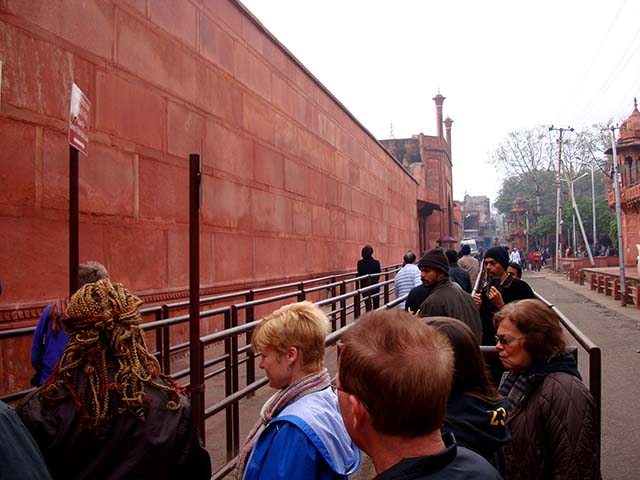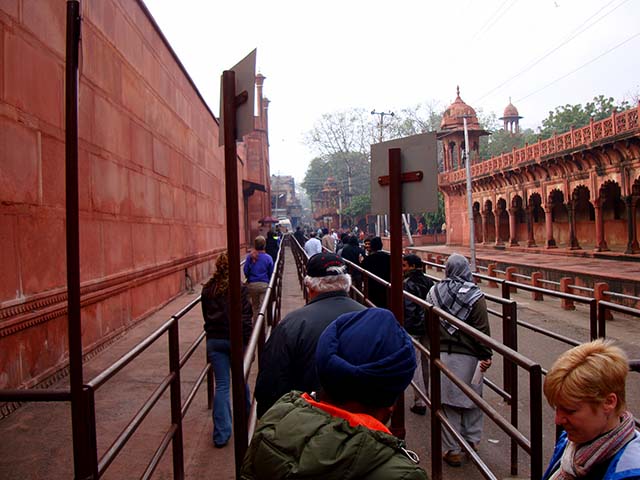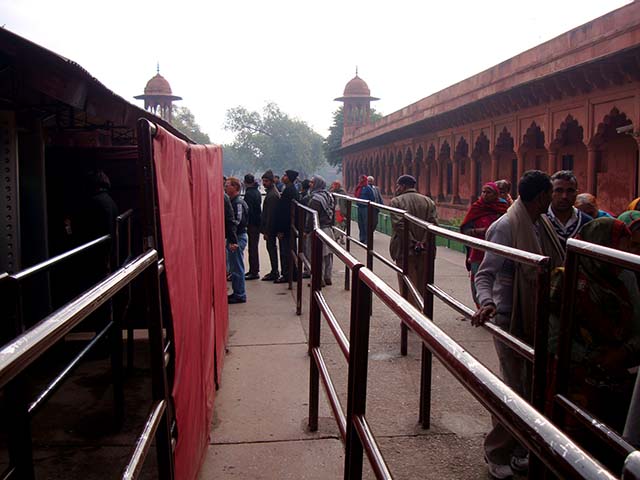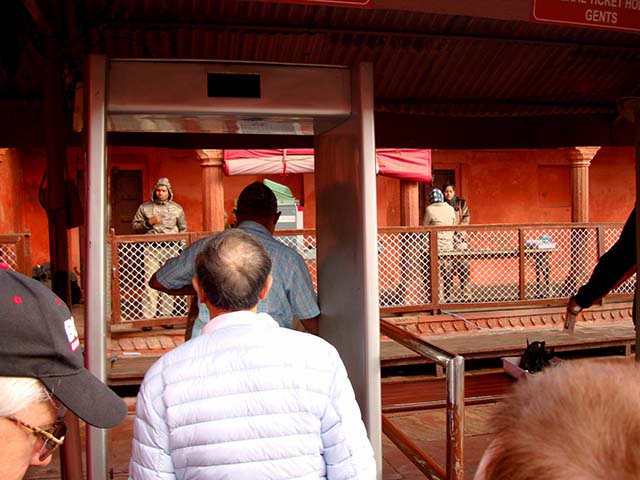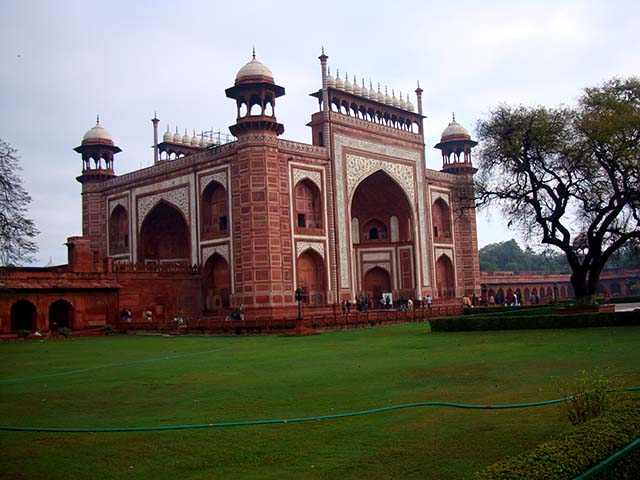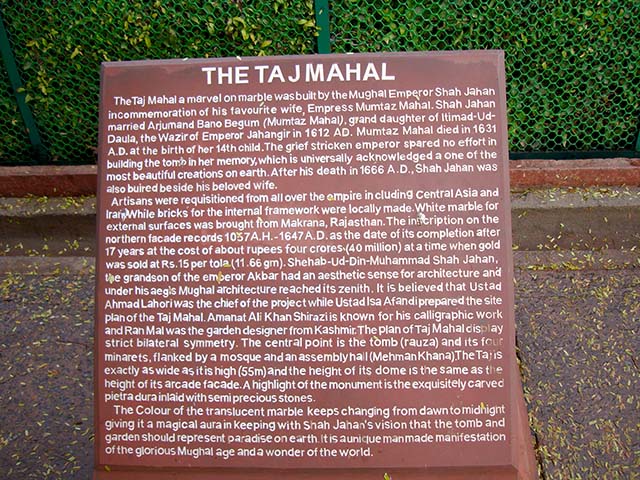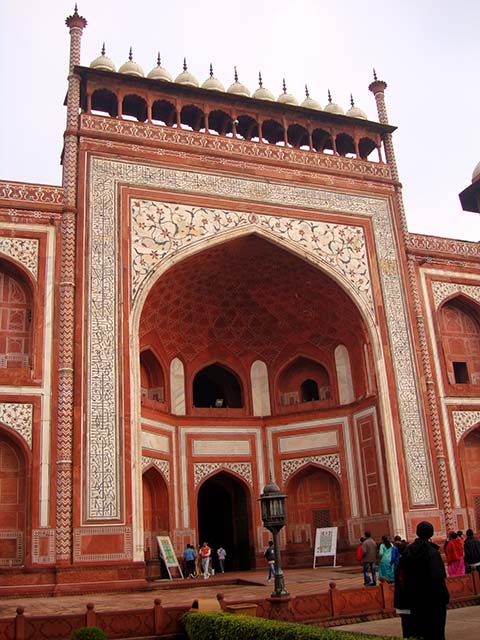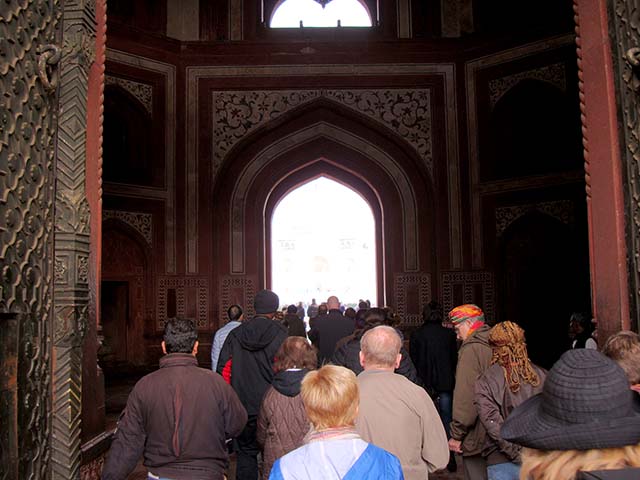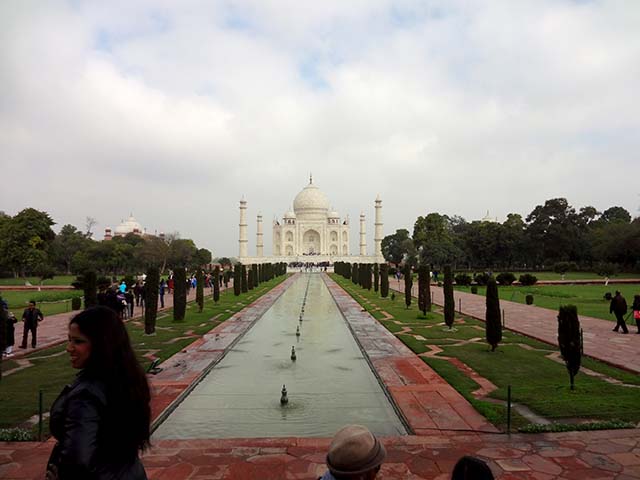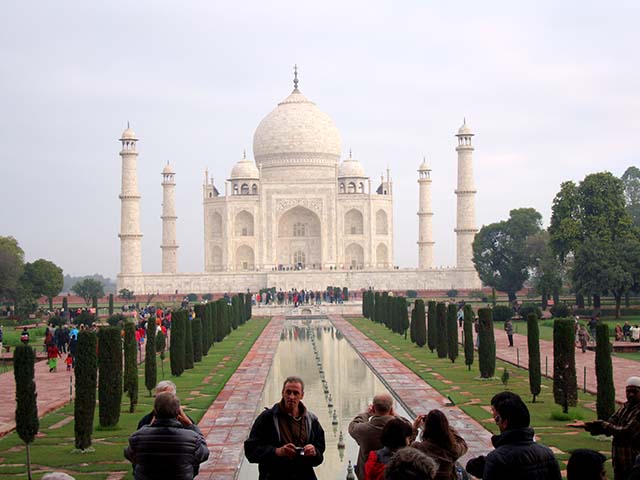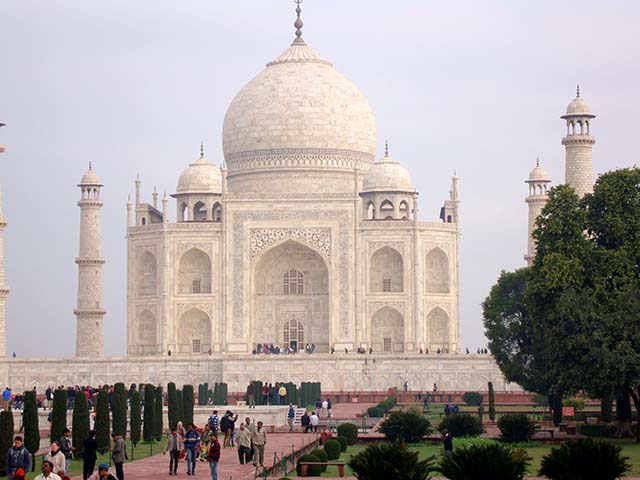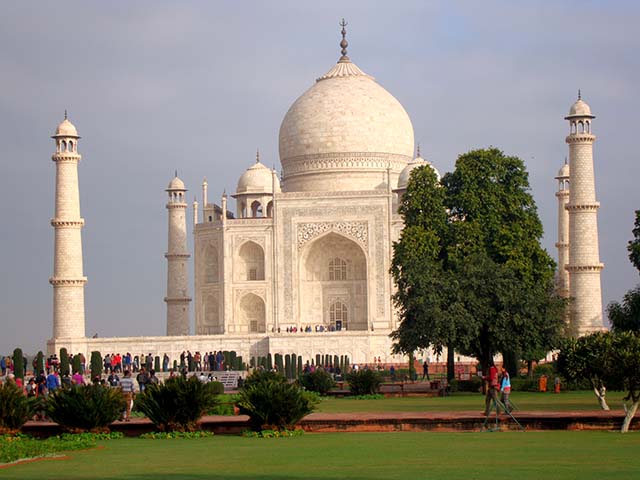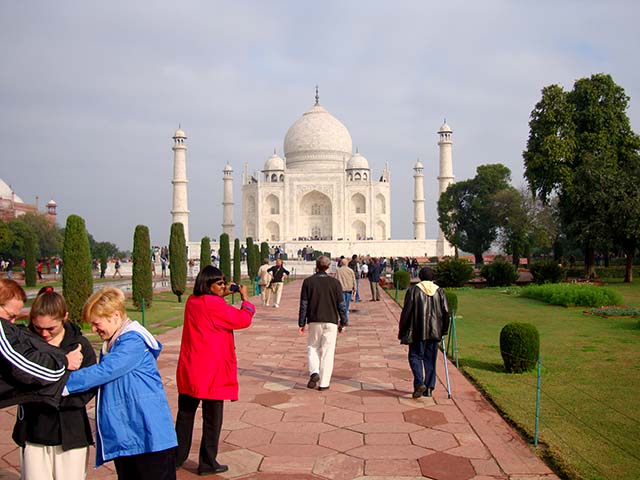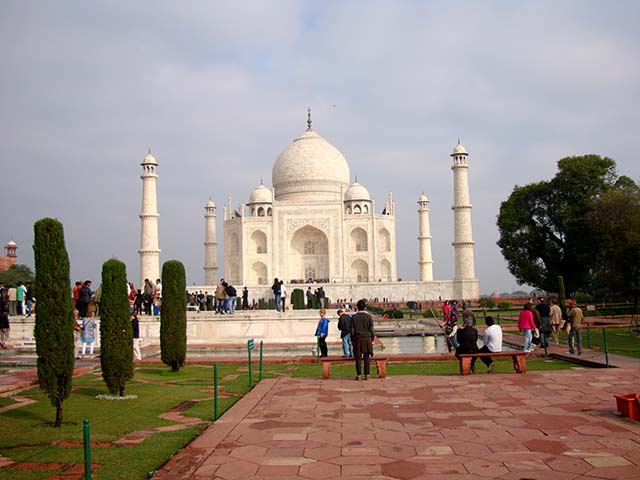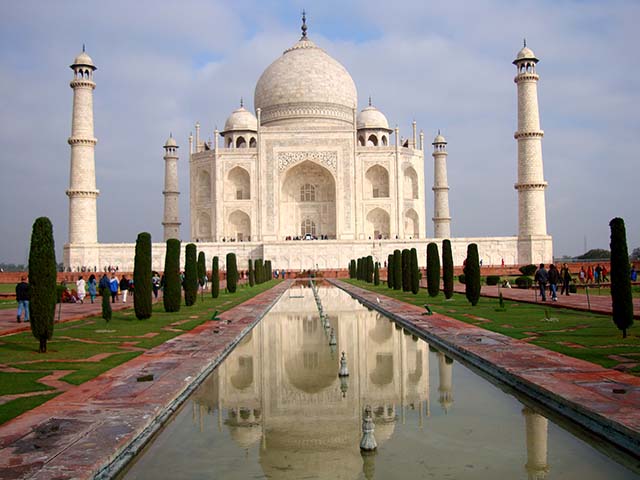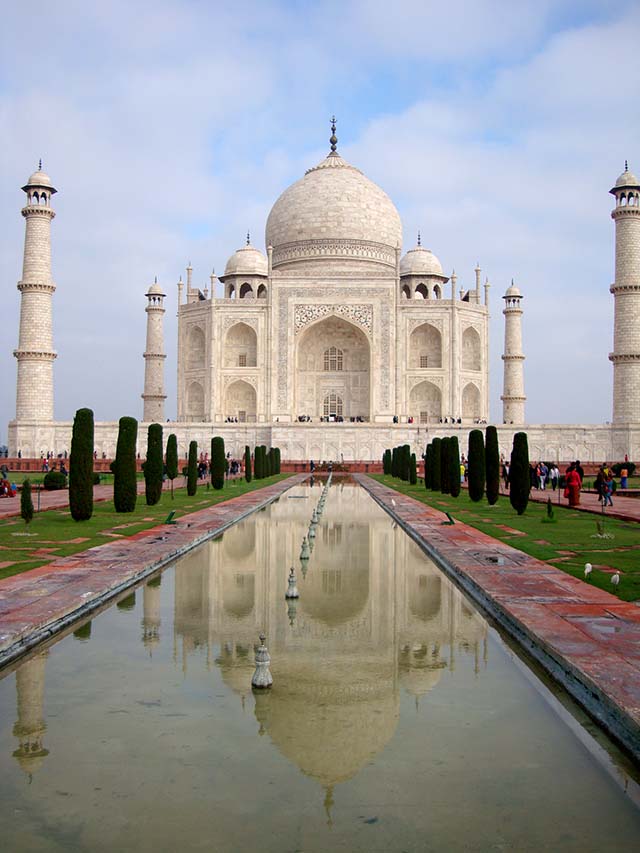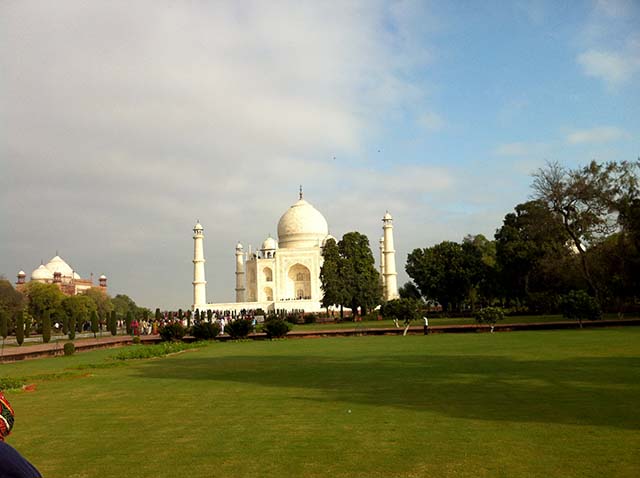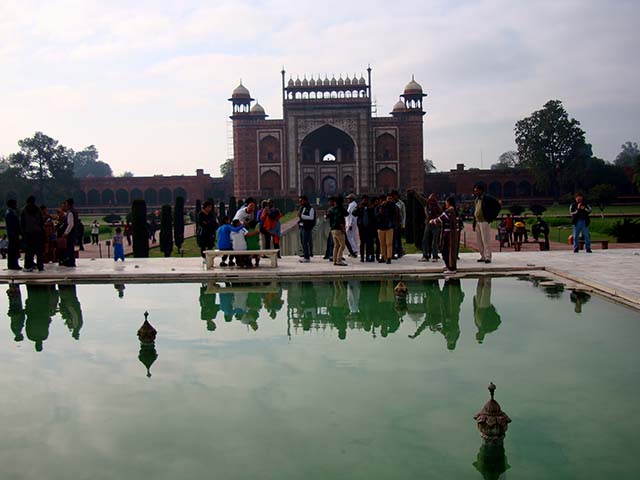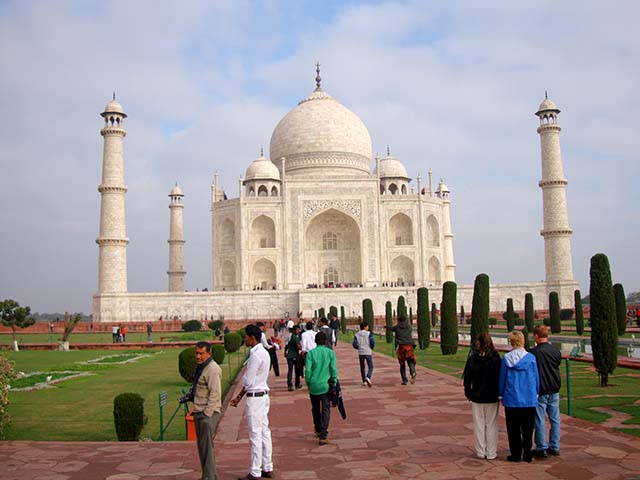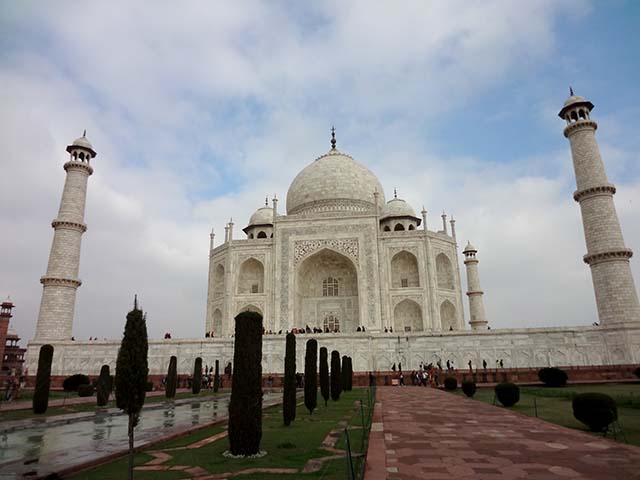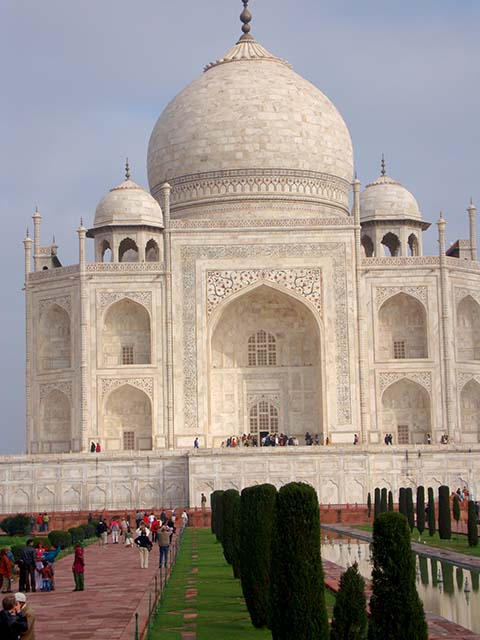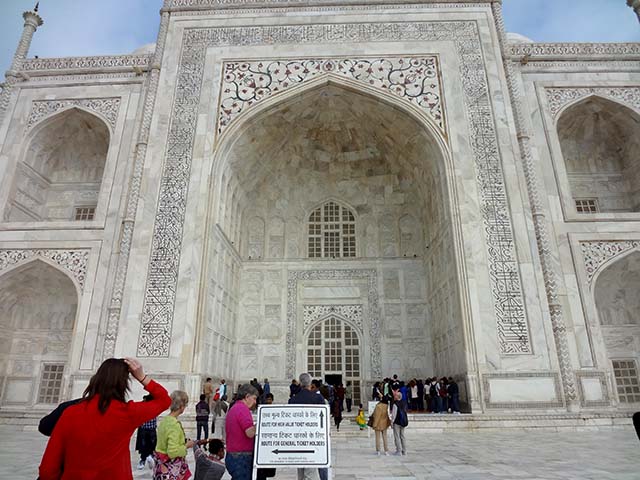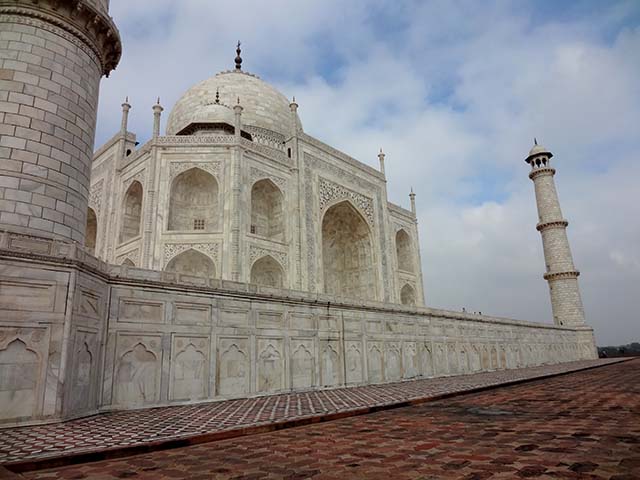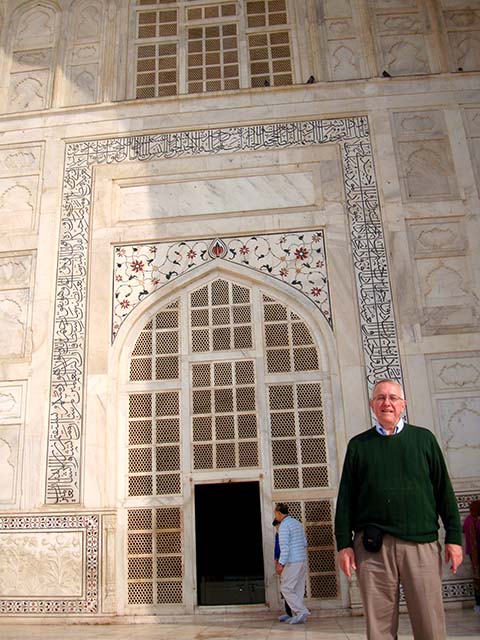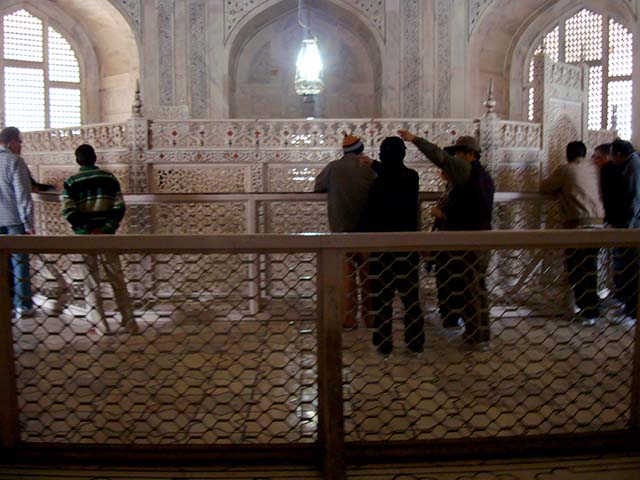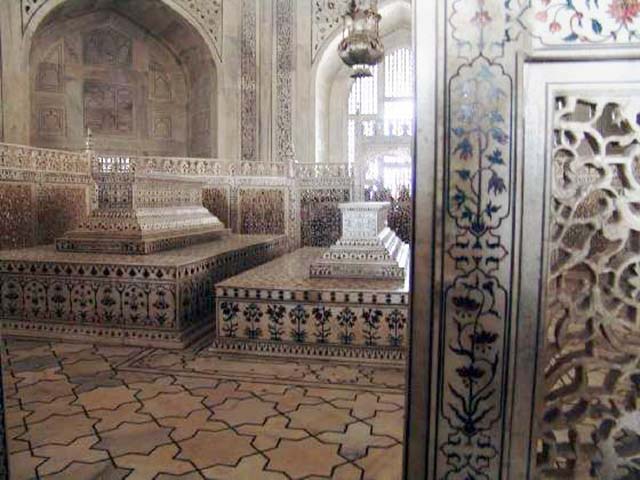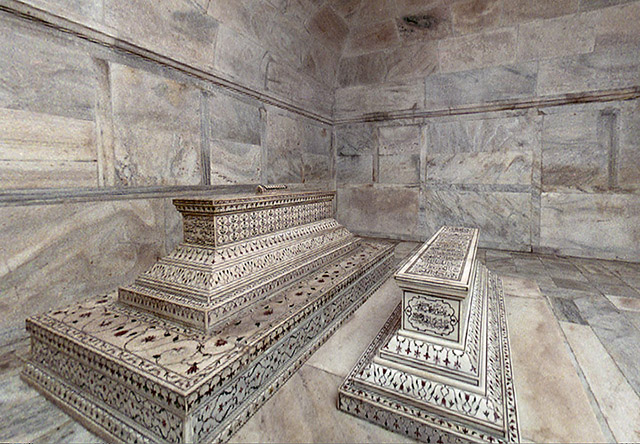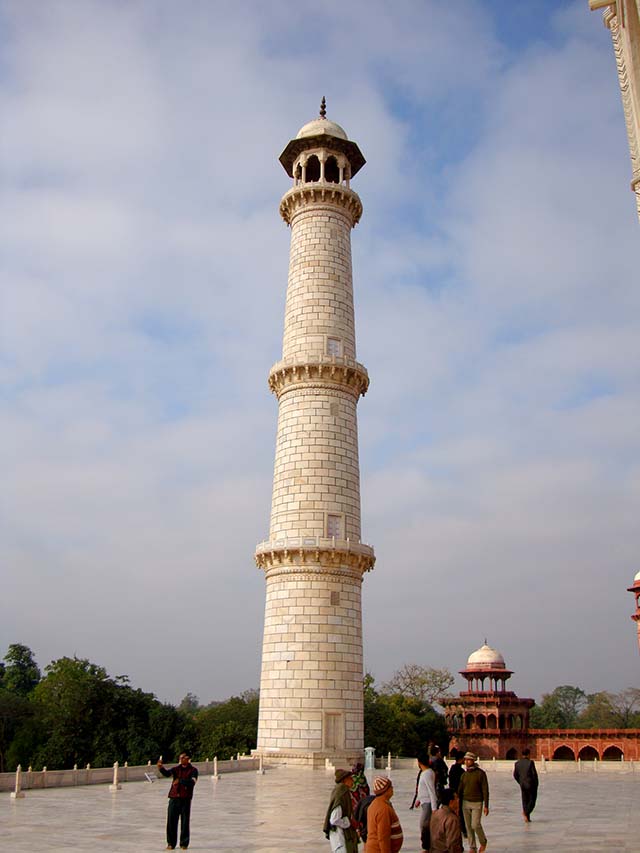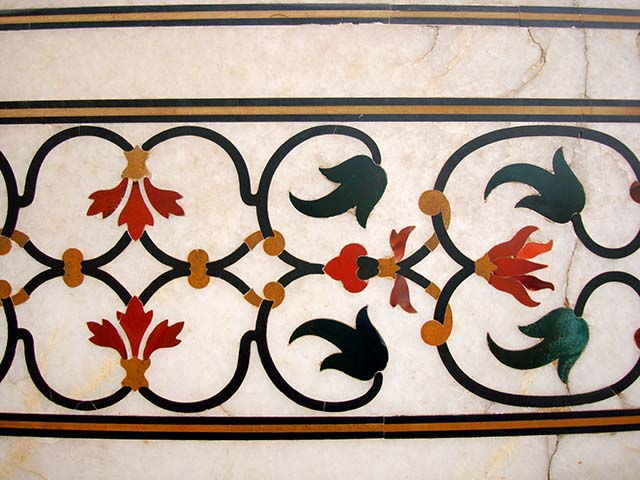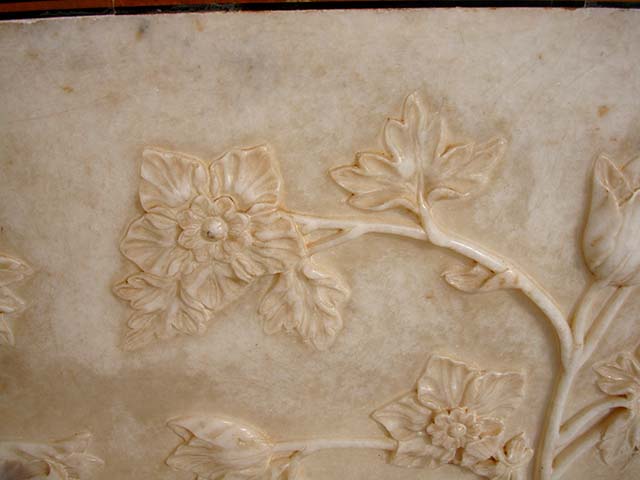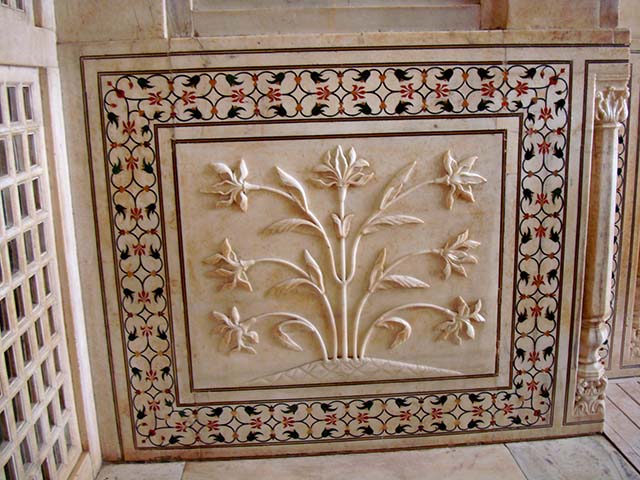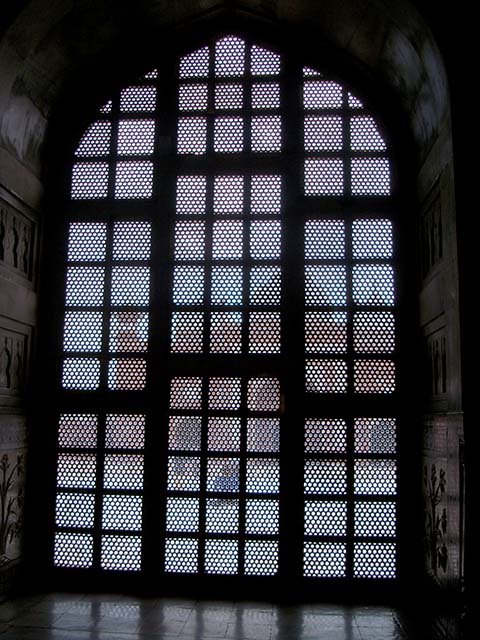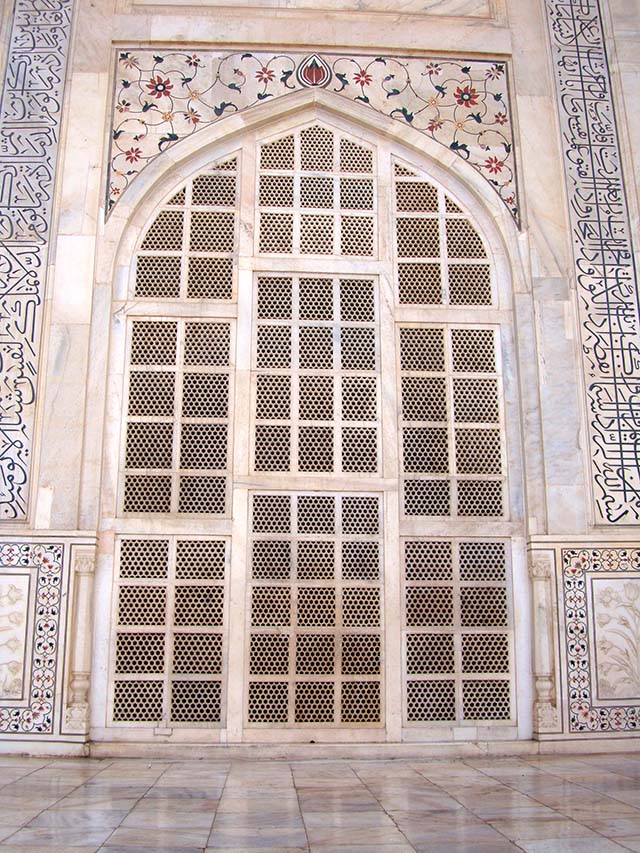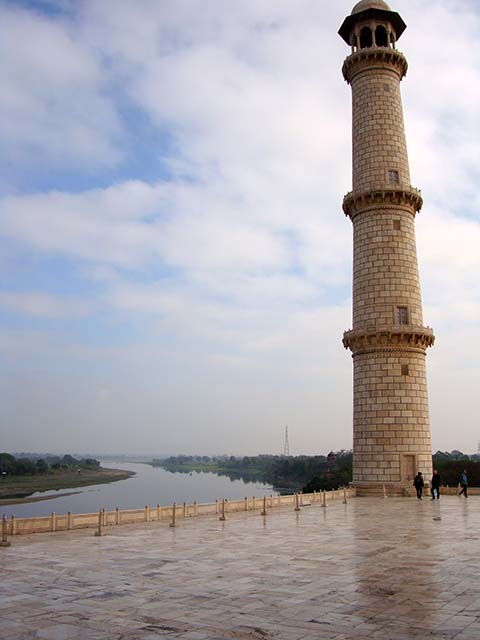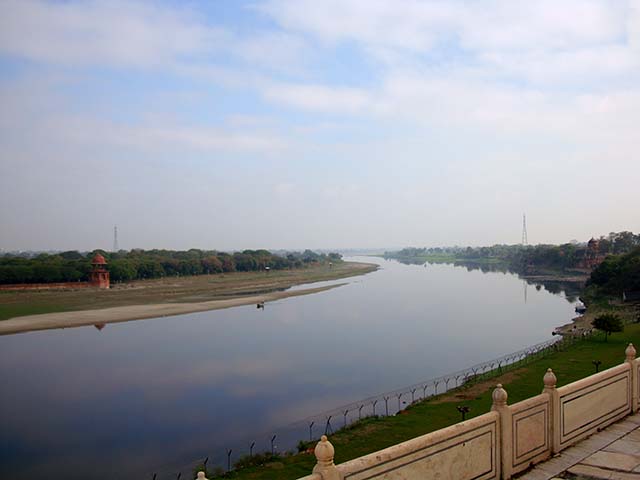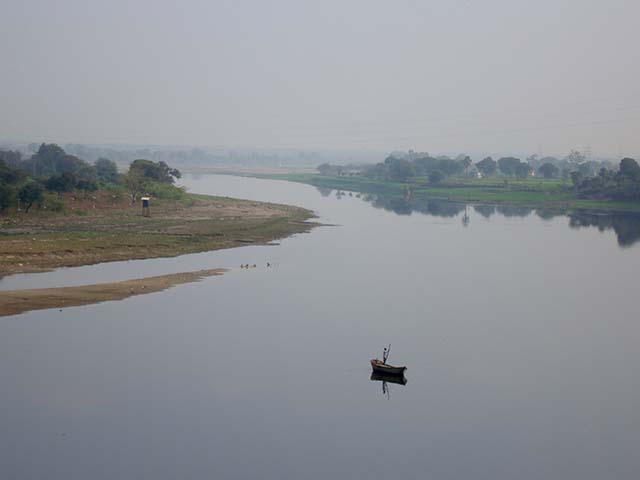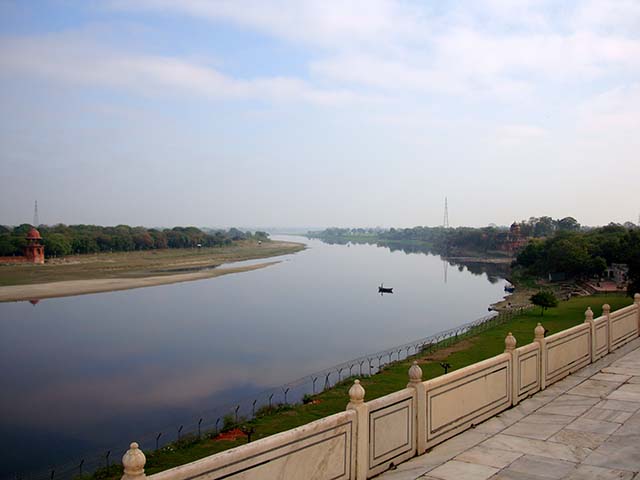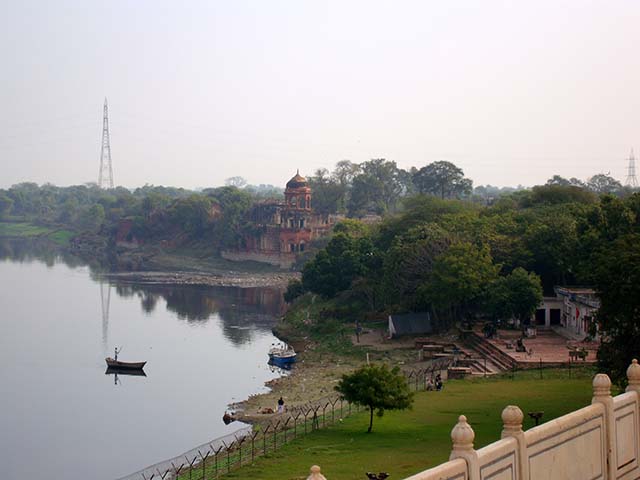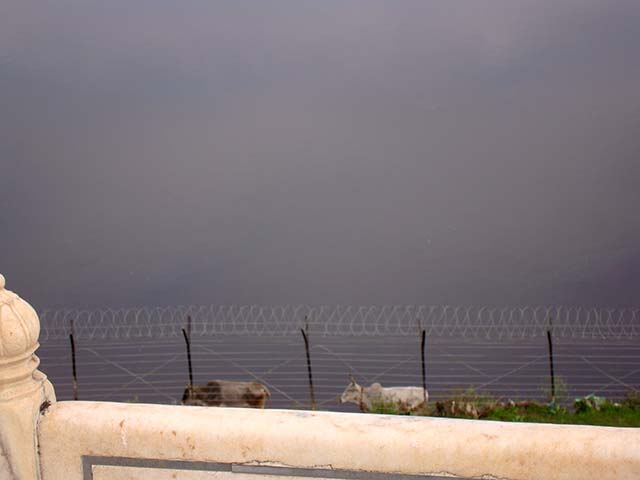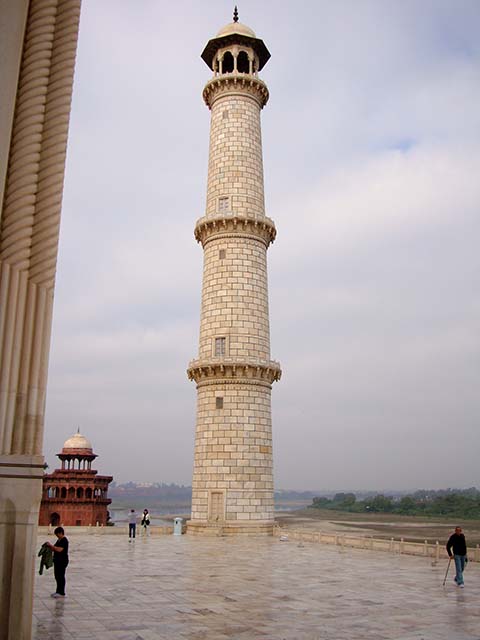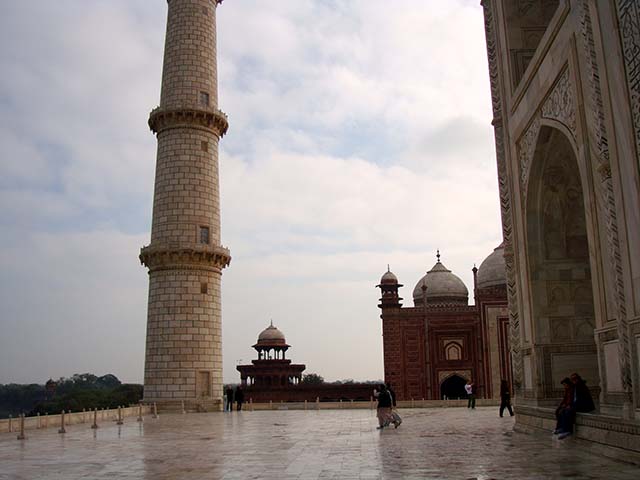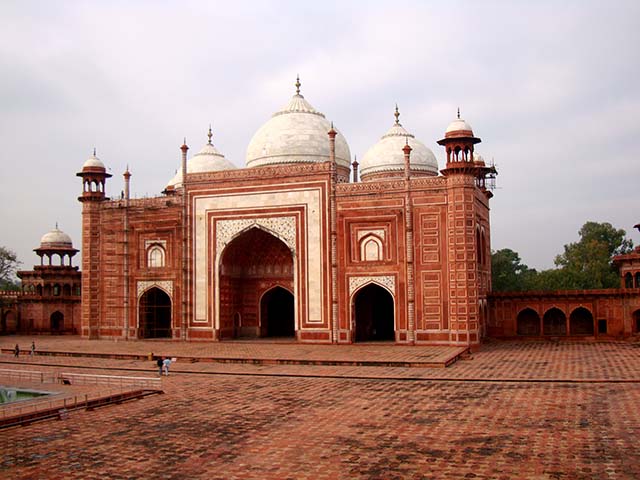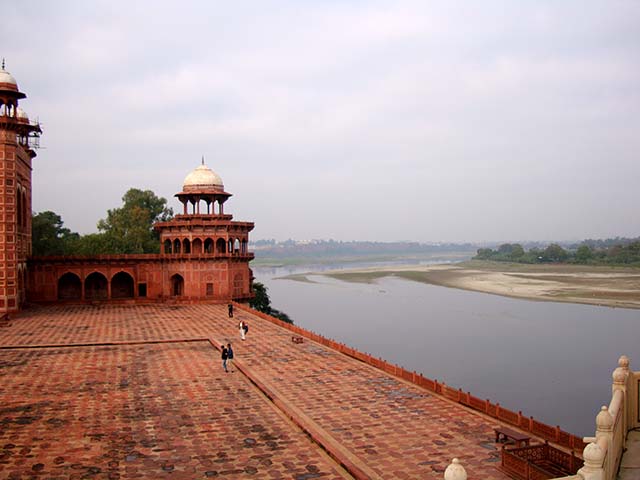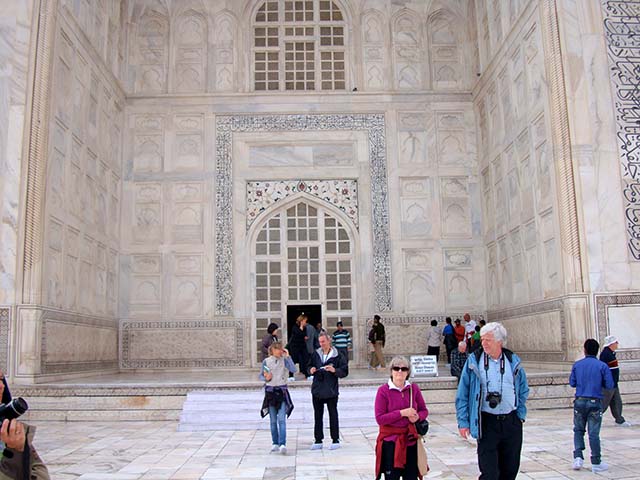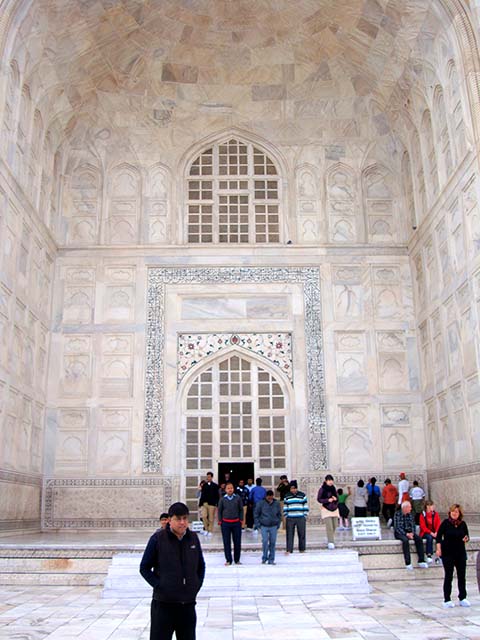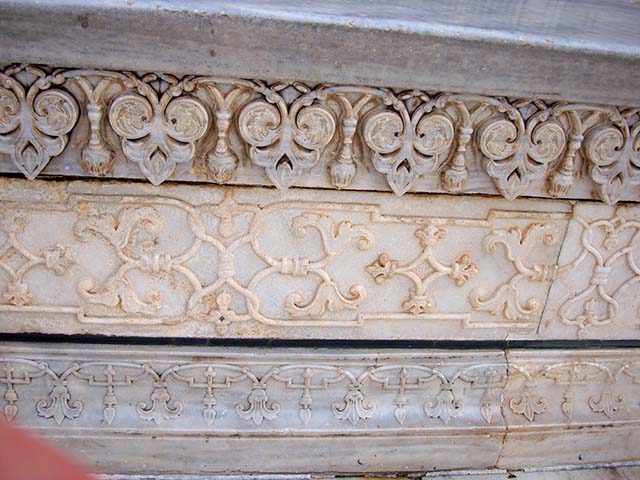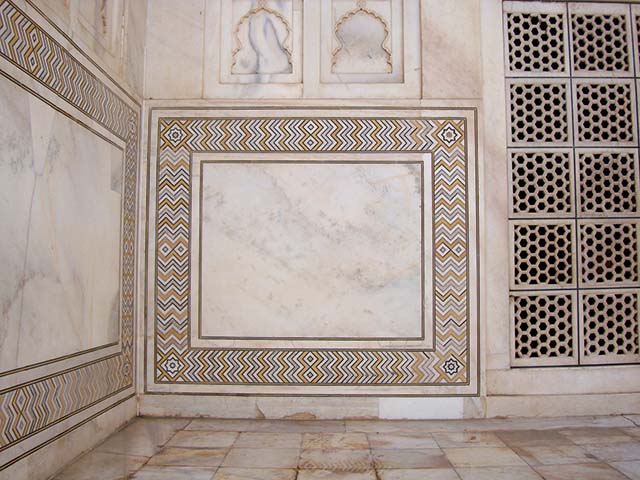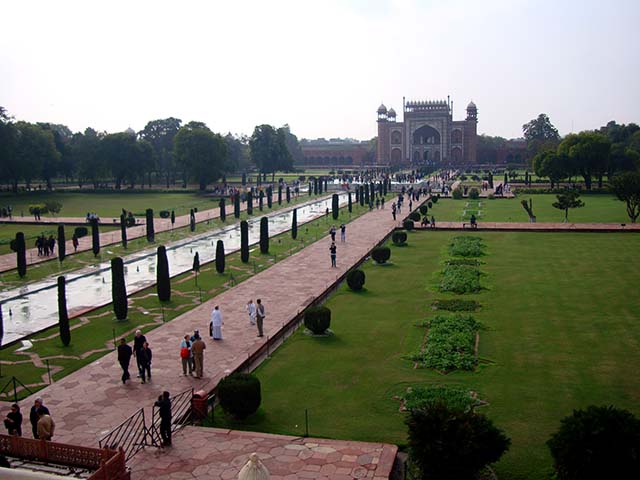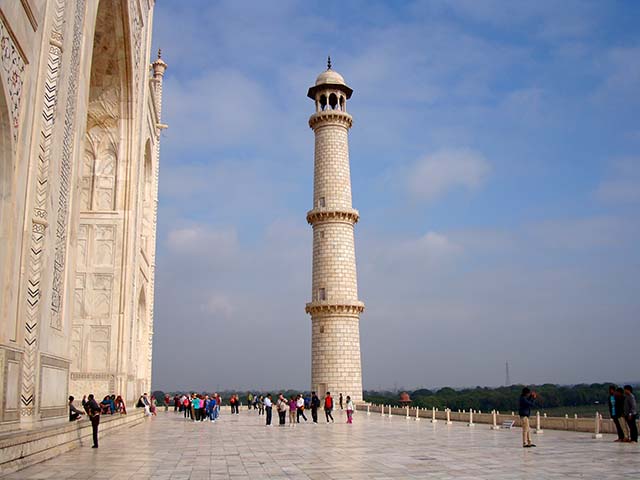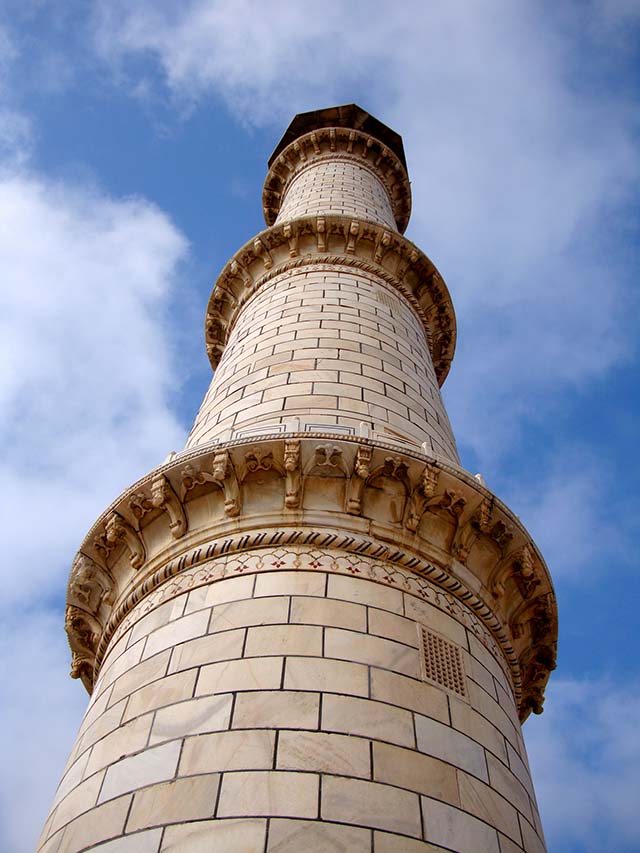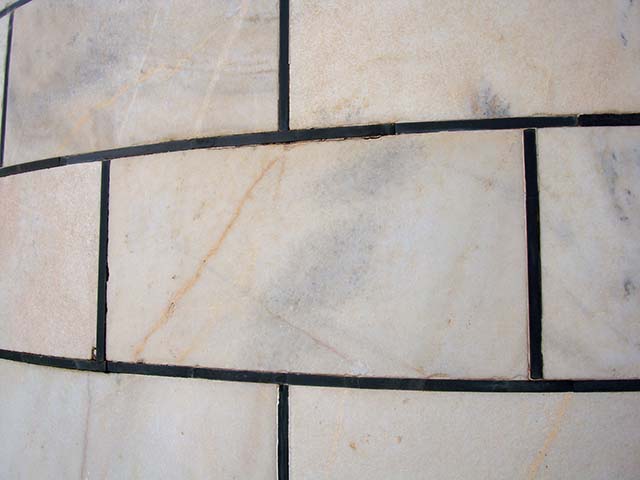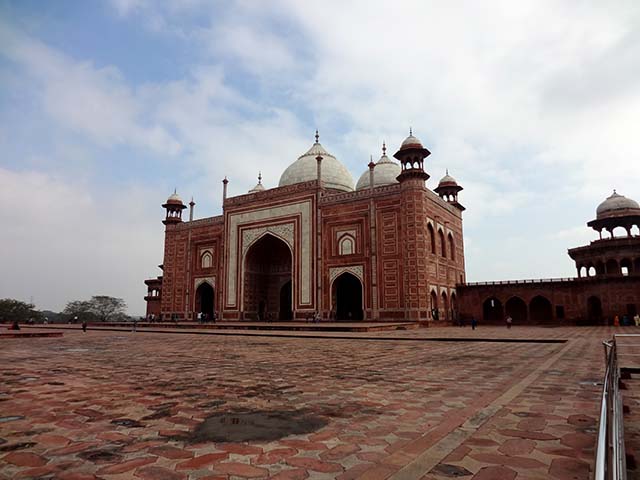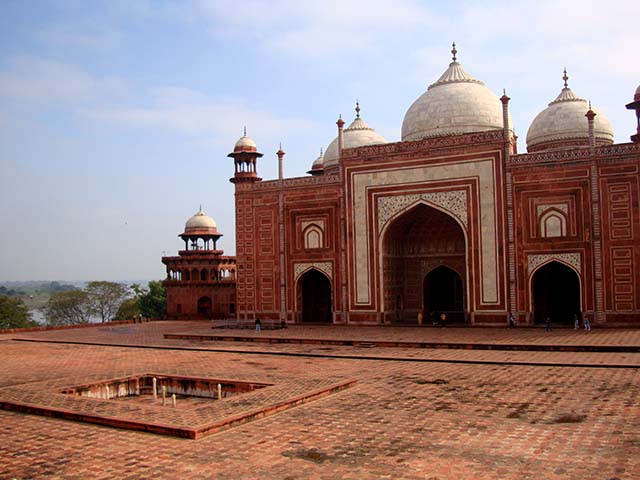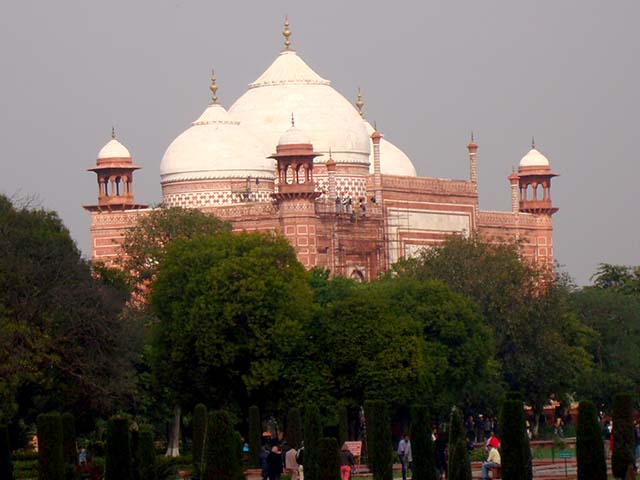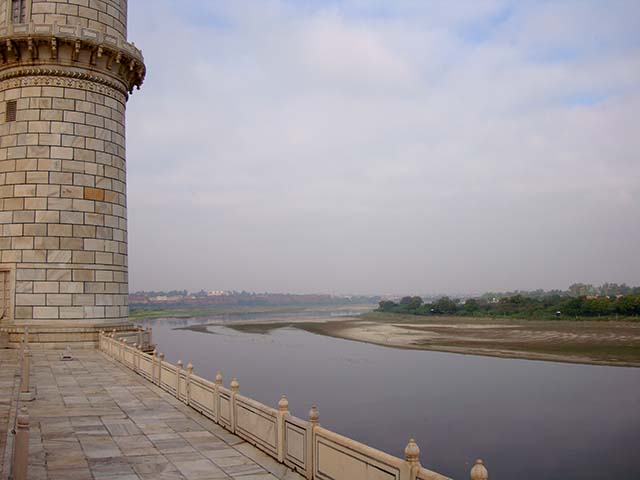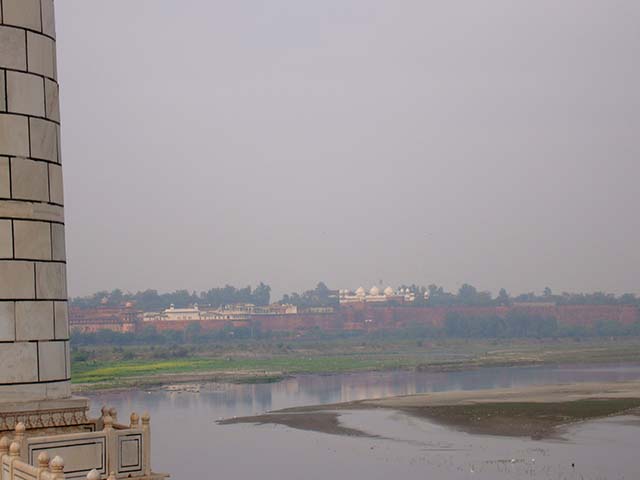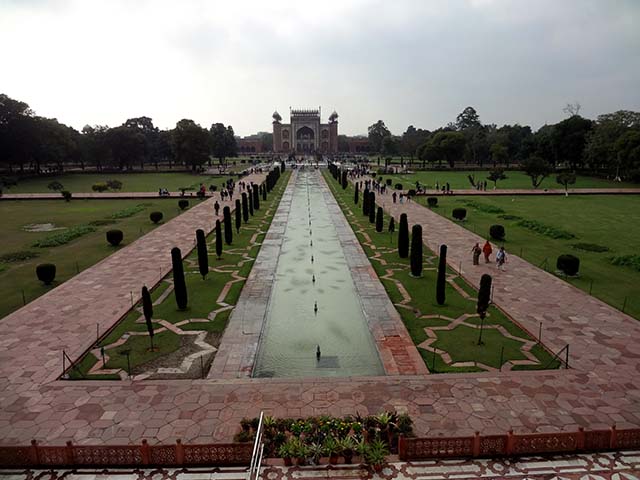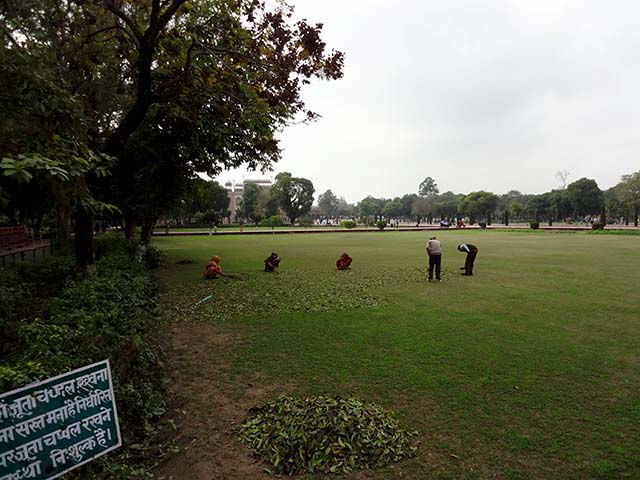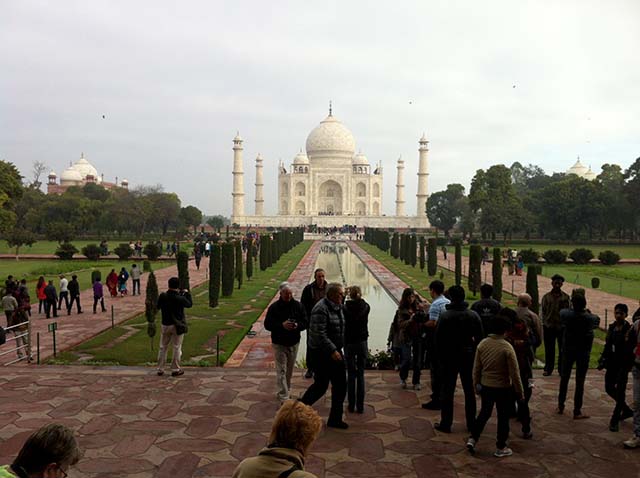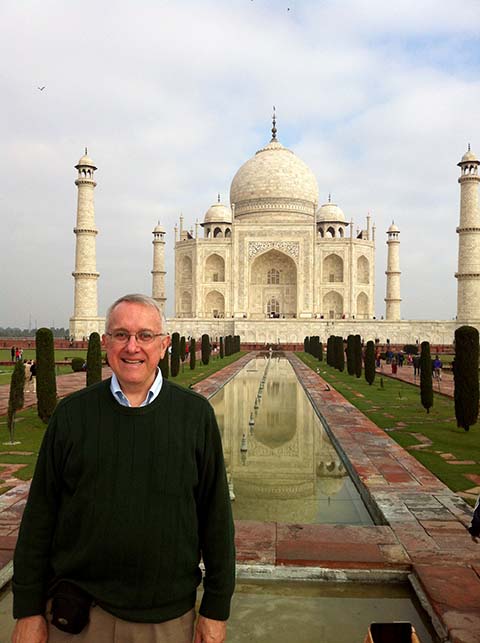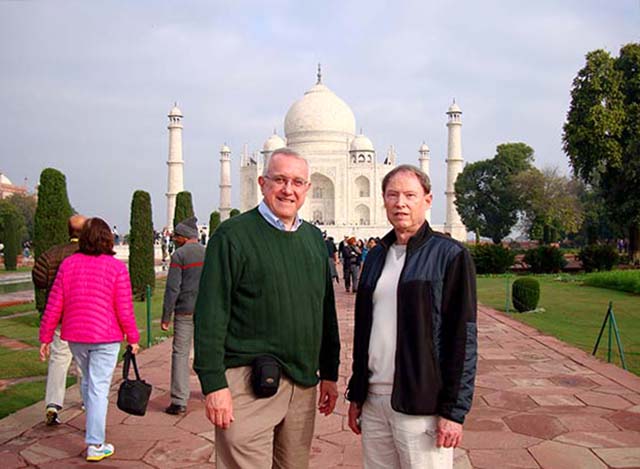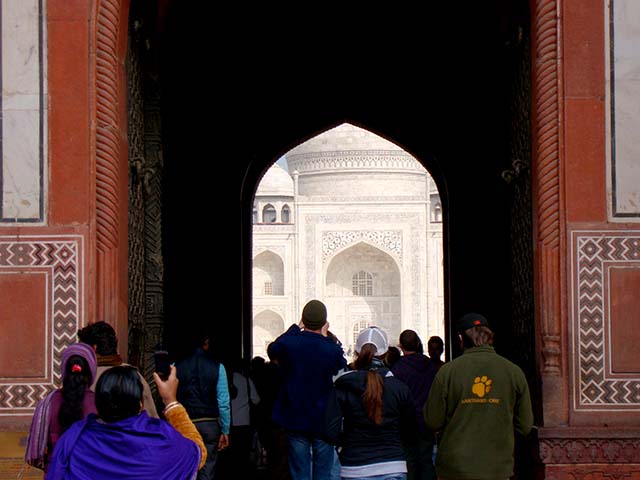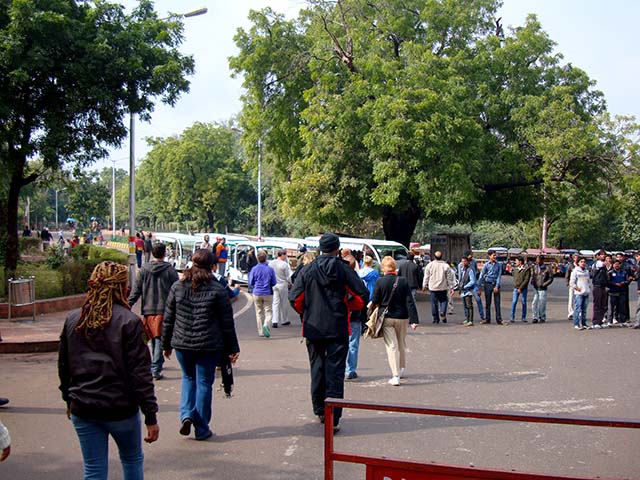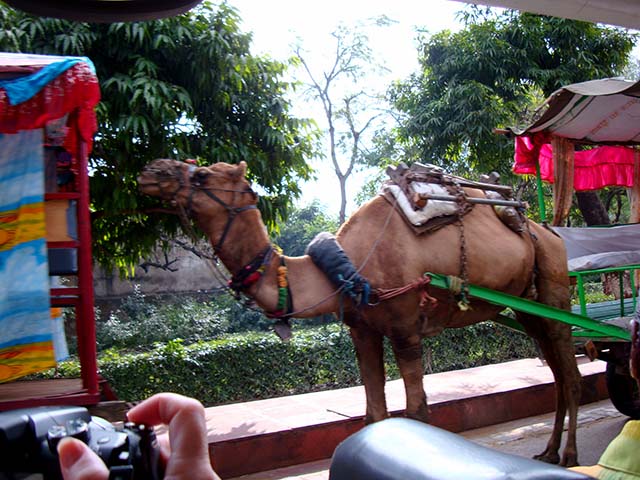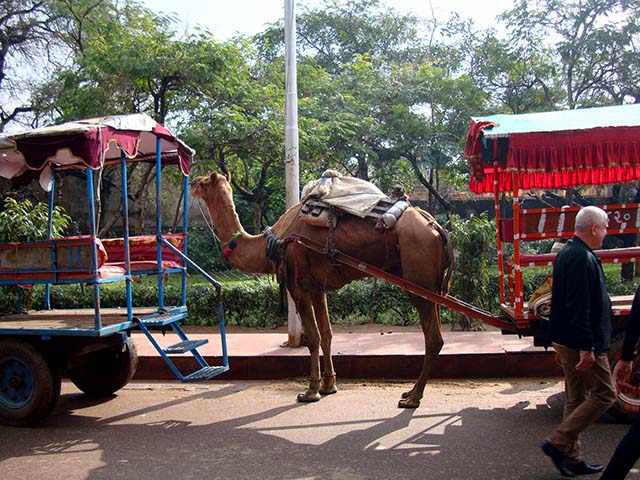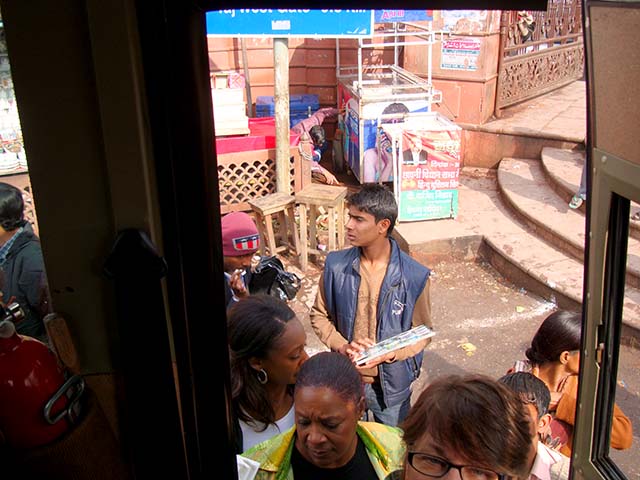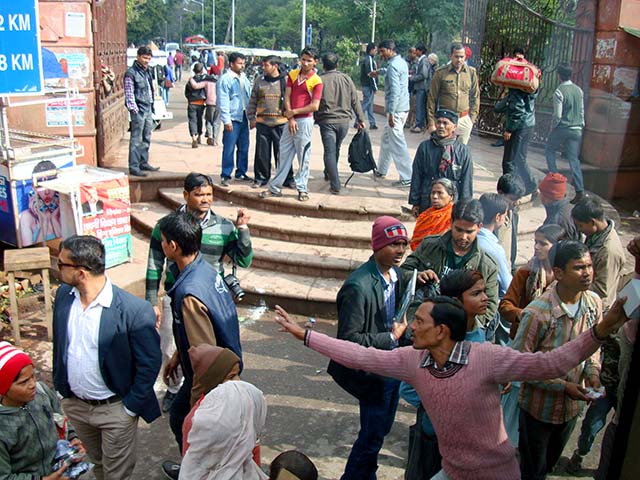So.... Davinder brought us all to the lobby of the Trident Hotel and laid out the situation: We could go to the Taj Mahal today...the day we were scheduled to go...but it was pouring rain. and he'd been to the Taj Mahal before in these conditions, and everybody in his group was miserable because they couldn't see a thing, and the visit was a disaster.... So.... Would we like to go today, which we absolutely can do, or wait until tomorrow morning when the weather forecast says conditions will likely be about the same? Misery today, or possibly the same misery tomorrow, with a chance of improvement but no guarantees? The vote was mixed at first, but eventually the group decided to wait until tomorrow morning. Great call, group!
Remember that wet gate where we didn't get out of the bus yesterday? Well, it's mostly dry this morning. Yay!
Looks like we could take a camel cart to the Taj.
But instead we're going to ride in oversized golf carts.
Looks like some people enjoy observing the parade of tourists.
Want to ride along with us? Well, have a look at this Flash video.
Now we're there. Well, now we're at the main entrance, anyway. Davinder is getting ready to manage all our tickets.
Davinder insisted we come early, and look! He was right! This is where the tourists line up, but there's practically nobody here in front of us!
And thanks to Davinder, we are "high value" tourists!
So into the cattle stalls we go.
Men this way, women that way.
They take their security seriously here, and for good reason. Everybody's going to be patted down.
The men line up to be checked for sharp objects. You can't take a knife inside or any other instrument that might be used to pry precious stones from the walls of the Taj Mahal.
Bill almost didn't make it inside. The guard thought his eye drops looked like little precious stone-pryers.
Those aren't eye drops! Yes, they are! Watch me twist off this little tab.... Oh, never mind, go on in.
So we're going in over there.
Let's read all about it before we see it.
Getting closer. The entrance is nice enough to be worth the trip.
There's something through that door.
Must be something special, because that's where everybody's going.
Wow.
Wow.
Davinder had predicted his tourists would say, "wow," and as usual, Davinder was correct.
I mean really...wow.
As with all the descriptive passages on this page, the following is taken from Wikipedia: The Taj Mahal, from Arabic "crown of palaces,” is a white marble mausoleum located in Agra, Uttar Pradesh, India. It was built by Mughal emperor Shah Jahan in memory of his third wife, Mumtaz Mahal. The Taj Mahal is widely recognized as "the jewel of Muslim art in India and one of the universally admired masterpieces of the world's heritage.”
The Taj Mahal is regarded by many as the finest example of Mughal architecture, a style that combines elements from Islamic, Persian, Ottoman Turkish and Indian architectural styles.
Margo is grabbing a picture. One of many, I suspect.
In 1983, the Taj Mahal became a UNESCO World Heritage Site. While the white domed marble mausoleum is the most familiar component of the Taj Mahal, it is actually an integrated complex of structures. The construction began around 1632 and was completed around 1653, employing thousands of artisans and craftsmen. The construction of the Taj Mahal was entrusted to a board of architects under imperial supervision, including Abd ul-Karim Ma'mur Khan, Makramat Khan, and Ustad Ahmad Lahauri. Lahauri is generally considered to be the principal designer.
In 1631, Shah Jahan, emperor during the Mughal empire's period of greatest prosperity, was grief-stricken when his third wife, Mumtaz Mahal, a Persian princess, died during the birth of their 14th child, Gauhara Begum. Construction of the Taj Mahal began in 1632. The court chronicles of Shah Jahan's grief illustrate the love story traditionally held as an inspiration for Taj Mahal. The principal mausoleum was completed in 1648 and the surrounding buildings and garden were finished five years later.
Emperor
Shah Jahan himself described the Taj in these words:
The sun decided to be kind to us this morning, popping out from behind the clouds more than once. The Taj Mahal incorporates and expands on design traditions of Persian architecture and earlier Mughal architecture. Specific inspiration came from successful Timurid and Mughal buildings including; the Gur-e Amir (the tomb of Timur, progenitor of the Mughal dynasty, in Samarkand), Humayun's Tomb (which we saw on this trip), Itmad-Ud-Daulah's Tomb (sometimes called the Baby Taj, and which we also saw on this trip), and Shah Jahan's own Jama Masjid in Delhi (which, you guessed it, we saw on this trip). While earlier Mughal buildings were primarily constructed of red sandstone, Shah Jahan promoted the use of white marble inlaid with semi-precious stones, and buildings under his patronage reached new levels of refinement.
When the sun pops out, the Taj Mahal is dazzling.
It was hard for Bill to tear his eyes away from the Taj, but there were other interesting sights around here.
Like the back side of the entrance.
But as this Flash video illustrates, it was hard not to keep gazing upon that brilliant vision in white.
I mean, just look at that.
The marble dome that surmounts the tomb is the most spectacular feature. Its height of around 35 metres (115 ft) is about the same as the length of the base, and is accentuated as it sits on a cylindrical "drum" which is roughly 7 metres (23 ft) high. Because of its shape, the dome is often called an onion dome or amrud (guava dome). The top is decorated with a lotus design, which also serves to accentuate its height. The shape of the dome is emphasised by four smaller domed chattris (kiosks) placed at its corners, which replicate the onion shape of the main dome. Their columned bases open through the roof of the tomb and provide light to the interior. Tall decorative spires (guldastas) extend from edges of base walls, and provide visual emphasis to the height of the dome. The lotus motif is repeated on both the chattris and guldastas. The dome and chattris are topped by a gilded finial, which mixes traditional Persian and Hindustani decorative elements.
The main finial was originally made of gold but was replaced by a copy made of gilded bronze in the early 19th century. This feature provides a clear example of integration of traditional Persian and Hindu decorative elements. The finial is topped by a moon, a typical Islamic motif whose horns point heavenward. Because of its placement on the main spire, the horns of the moon and the finial point combine to create a trident shape, reminiscent of traditional Hindu symbols of Shiva.
The tourists must prepare their feet before they're allowed into the Taj Mahal itself.
The tomb is the central focus of the entire complex of the Taj Mahal. This large, white marble structure stands on a square plinth and consists of a symmetrical building with an iwan (an arch-shaped doorway) topped by a large dome and finial. Like most Mughal tombs, the basic elements are Persian in origin.
And with our feet all neatly covered, up to the tomb we went.
It just keeps getting more and more impressive.
See what I mean?
The inlaid stone decorations on the outer walls are beautiful. And the sky is almost completely clear. Is that great, or what?
The calligraphy on the Great Gate reads "O Soul, thou art at rest. Return to the Lord at peace with Him, and He at peace with you." The calligraphy was created by a calligrapher named Abd ul-Haq, in 1609. Shah Jahan conferred the title of "Amanat Khan" upon him as a reward for his "dazzling virtuosity". Near the lines from the Qur'an at the base of the interior dome is the inscription, "Written by the insignificant being, Amanat Khan Shirazi." Much of the calligraphy is composed of florid thuluth script, made of jasper or black marble, inlaid in white marble panels. Higher panels are written in slightly larger script to reduce the skewing effect when viewed from below. The calligraphy found on the marble cenotaphs in the tomb is particularly detailed and delicate.
Bill has given up trying to read the calligraphy, so he's going to look inside.
No cameras were allowed inside the tomb, but that didn't stop Bill from sneaking a shot of the interior through an open spot in one of the windows. Two false tombs (cenotaphs) are over there behind that octagonal screen. Davinder had told us about this: the tombs everybody can see are empty; the real tombs are directly underneath them in a simple basement room.
Bill grabbed this picture and the next from Wikipedia. The octagonal marble screen or jali which borders the cenotaphs is made from eight marble panels which have been carved through with intricate pierce work. The remaining surfaces have been inlaid in extremely delicate detail with semi-precious stones forming twining vines, fruits and flowers. The interior chamber of the Taj Mahal steps far beyond traditional decorative elements. Here, the inlay work is not pietra dura, but a lapidary of precious and semiprecious gemstones. The inner chamber is an octagon with the design allowing for entry from each face, although only the door facing the garden to the south is used. The interior walls are about 25 metres (82 ft) high and are topped by a "false" interior dome decorated with a sun motif. Eight pishtaq arches define the space at ground level and, as with the exterior, each lower pishtaq is crowned by a second pishtaq about midway up the wall. The four central upper arches form balconies or viewing areas, and each balcony's exterior window has an intricate screen or jali cut from marble. In addition to the light from the balcony screens, light enters through roof openings covered by chattris at the corners. Each chamber wall has been highly decorated with dado bas-relief, intricate lapidary inlay and refined calligraphy panels, reflecting in miniature detail the design elements seen throughout the exterior of the complex. Mumtaz Mahal's cenotaph is placed at the precise centre of the inner chamber on a rectangular marble base of 1.5 by 2.5 metres (4 ft 11 in by 8 ft 2 in). Shah Jahan's cenotaph is beside Mumtaz's to the western side, and is the only visible asymmetric element in the entire complex. His cenotaph is bigger than his wife's, but reflects the same elements: a larger casket on a slightly taller base, again decorated with astonishing precision with lapidary and calligraphy that identifies him. On the lid of this casket is a traditional sculpture of a small pen box. The pen box and writing tablet were traditional Mughal funerary icons decorating the caskets of men and women respectively. The Ninety Nine Names of God are found as calligraphic inscriptions on the sides of the actual tomb of Mumtaz Mahal, in the crypt including "O Noble, O Magnificent, O Majestic, O Unique, O Eternal, O Glorious... ". The tomb of Shah Jahan bears a calligraphic inscription that reads; "He travelled from this world to the banquet-hall of Eternity on the night of the twenty-sixth of the month of Rajab, in the year 1076 Hijri."
The real caskets are in a crypt directly below the cenotaphs. Again, Bill grabbed this picture from Wikipedia. Muslim tradition forbids elaborate decoration of graves. Hence, the bodies of Mumtaz and Shah Jahan were put in a relatively plain crypt beneath the inner chamber with their faces turned right and towards Mecca. Both the base and casket are elaborately inlaid with precious and semiprecious gems. Calligraphic inscriptions on the casket identify and praise Mumtaz. On the lid of the casket is a raised rectangular lozenge meant to suggest a writing tablet.
The minarets are slightly tilted, but when viewed from a distance they appear perfectly vertical.
On the lower walls of the tomb there are white marble dados that have been sculpted with realistic bas relief depictions of flowers and vines.
The marble has been polished to emphasise the exquisite detailing of the carvings....
....and the dado frames and archway spandrels have been decorated with pietra dura inlays of highly stylised, almost geometric vines, flowers and fruits. The inlay stones are of yellow marble, jasper and jade, polished and levelled to the surface of the walls.
Very intricate and just beautiful.
There are dark or black inlays on the white marbles. Mortared areas of the marble buildings have been stained or painted in a contrasting colour, creating geometric patterns of considerable complexity.
Who needs glass for windows when you can have perforated marble? You can see out through this stuff....
But you can't see in. Nice, huh?
Floors and walkways use contrasting tiles or blocks in tessellation patterns.
Everything about this place seems peaceful, even the river.
Wait, is that somebody in a boat out there?
I do believe there is somebody out there on that completely placid river. Is he fishing?
No, maybe just making a river crossing from that cupola on the left....
....to the cupola on the right. It's all part of the Taj Mahal complex of gardens and buildings. The garden across the the river is called the Mehtab Bagh.
Holy cows.
Yes, it does lean outward just a little. And yes, that's on purpose.
Just looking around out back.
That's a mosque over there.
Nice...but we didn't go there.
We just enjoyed the view from the Taj.
The scale is immense.
The place dwarfs the tourists.
And everyone's impressed.
The marble reliefs are intricately carved.
Herringbone inlays define the space between many of the adjoining elements.
The base structure is essentially a large, multi-chambered cube with chamfered corners, forming an unequal octagon that is approximately 55 metres (180 ft) on each of the four long sides. On each of these sides, a huge pishtaq, or vaulted archway, frames the iwan with two similarly shaped, arched balconies stacked on either side. This motif of stacked pishtaqs is replicated on the chamfered corner areas, making the design completely symmetrical on all sides of the building. Four minarets frame the tomb, one at each corner of the plinth facing the chamfered corners. The main chamber houses the false sarcophagi of Mumtaz Mahal and Shah Jahan; the actual graves are at a lower level.
View of the gardens from the Taj.
The minarets, which are each more than 40 metres (130 ft) tall, display the designer's penchant for symmetry. They were designed as working minarets—a traditional element of mosques, used by the muezzin to call the Islamic faithful to prayer. Each minaret is effectively divided into three equal parts by two working balconies that ring the tower. At the top of the tower is a final balcony surmounted by a chattri that mirrors the design of those on the tomb. The chattris all share the same decorative elements of a lotus design topped by a gilded finial. The minarets were constructed slightly outside of the plinth so that, in the event of collapse, (a typical occurrence with many tall constructions of the period) the material from the towers would tend to fall away from the tomb.
A closer look at one of the minarets.
An even closer look. Mortared areas of the marble buildings have been stained or painted in a contrasting colour, creating geometric patterns of considerable complexity.
There are nearly identical mosques like this on either side of the Taj Mahal.
White inlays are used in sandstone buildings.
Looks much like the one on the other side of the Taj.
Hey! Off there in the distance! It's Agra Fort, where Shah Jahan lived out his final days in exile, gazing from his balcony across the river upon the Taj Mahal!
The telephoto lens brings it a little closer. Sure would have been nice if we could have seen the Taj Mahal from there yesterday as clearly as we can see Agra Fort from here today.
I wonder if Shah Jahan had binoculars?
I'm afraid it's about time to head back to the bus.
Keeping the place tidy.
It's been great, Taj. Sorry we have to leave you now. Bill wonders if he'll ever pass this way again. Probably not, but this trip was certainly worth the effort.
You are beautiful.
A jewel in the sun.
But Bill has to say goodbye.
Bill and Don agreed that unlike far to many tourist attractions, this one was every bit as wonderful as they'd been led to expect. A truly magnificent experience.
Last look through the gate.
And off to our bus.
Aw, Davinder, can't we take one of the camel-drawn transports?
I'm sure that big guy would like to pull us.
But no...we have to hurry back to the bus where the trinket salesmen are waiting to take our rupees.
To get on the bus you have to pass a gauntlet of trinkets.
Surely we can't leave without our very own miniature Taj Mahals?
Sorry, buddy, we've seen what we came for and we have to go home now.
|

